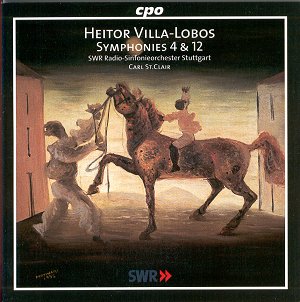Following on from the excellent first volume (CPO999
568-2, featuring Nos. 1 & 11 review)
of this first-ever integral survey of Villa-Lobos’s 12 symphonies, Carl
St. Clair and the Stuttgart Radio orchestra have reached the numerical
half-way stage with two further discs containing some of his finest.
The Fourth, "Victory" (1919), is probably the best known,
not least through the composer's own 1950s recording of it for EMI,
with the French Radio orchestra, which is still intermittently available
[see
also Dorian issue]. In the early days of CD, another archival
issue under the composer’s baton was in circulation of the Sixth, "On
the Profiles of the Mountains of Brasil" (1944).
The present newcomers surpass both of these in almost
every respect. Firstly, the sound is far superior (unsurprisingly),
also, despite Villa-Lobos’s inspirational qualities as a conductor in
his own music, the French orchestra are ragged compared to their latter-day
counterparts in Stuttgart, who rarely put a foot out of place. Now,
Villa-Lobos’s music often benefits from the odd rough edge—the orchestral
Bachianas Brasileiras are a case in point—but the symphonies,
with their more abstract idiom and reined-in expression need slickness
of execution. The Fourth in particular comes across as a strong piece,
its dazzling instrumentation sounding in many places like a concerto
for orchestra.
Villa-Lobos, unorthodox to the last as he was, was
not a great symphonic innovator, and the formal credentials of some
of the symphonies can seem tenuous. No. 10, not yet covered by CPO but
recorded by Gisèle Ben-Dor for Koch, is as much an oratorio as
a symphony, while Nos. 6 and 12 (1957) here are as aptly described as
Partitas, no more symphonic, perhaps than the more colourful Bachianas
Brasileiras. Three of the present clutch follow the same basic ground-plan,
common to most of his symphonies: preludial first movement, long adagio—the
expressive fulcrum of each work—scherzo and expansive finale where the
threads get tied up, Mahler-like, by the end. The Fourth does depart
from this by reversing the order of the inner movements, and following
the first movement by what amounts to a slow scherzo of almost equal
scale. It possesses an imagination of incident that is emulated completely
only by the Eighth (1950), with its masterful, if still somewhat thick
scoring. By contrast, No. 6 seems merely solid like the mountains whose
profiles its depicts, and from which Villa-Lobos is said to have derived
his themes as he had already done famously a cityscape in New York
Skyline (1939). There are some typically brilliant passages, but
overall the Sixth does sound a mite contrived. No. 12, by contrast,
which was very well received at its premiere, avoids this but with hindsight
is not as memorable as the Fourth or Eighth.
Carl St. Clair clearly has the measure of the style
and the music. The performances of Nos. 4, 8 and 12 are top-notch, that
of No. 6 seems less convincing as if in parallel to the work’s less
compelling inspiration. The sound quality, typically, is excellent:
rich, full and with depth. I look forward to the remaining instalments.
Guy Rickards


